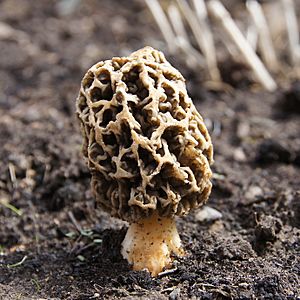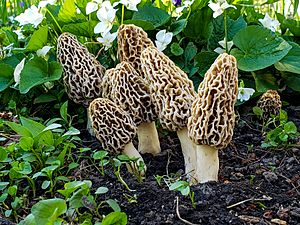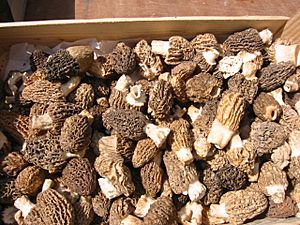Morchella esculenta facts for kids
Quick facts for kids Morchella esculenta |
|
|---|---|
 |
|
| Scientific classification | |
| Genus: |
Morchella
|
| Species: |
esculenta
|
 |
|
| Distribution map of Morchella esculenta | |
| Synonyms | |
| Morchella esculenta | |
|---|---|
| Mycological characteristics | |
| smooth hymenium | |
| cap is conical or ovate | |
| hymenium attachment is irregular or not applicable | |
| stipe is bare | |
| spore print is cream to yellow | |
| ecology is mycorrhizal or saprotrophic | |
| edibility: choice | |
The Morchella esculenta, often called the common morel or yellow morel, is a type of fungus. It belongs to the family Morchellaceae. This mushroom is one of the easiest to spot and is very popular for eating.
Each morel starts as a small, gray, sponge-like shape. It then grows into a larger, yellowish sponge with many pits and ridges. This cap sits on a large white stem. The cap is usually 2–7 centimetres (1–3 inches) wide and 2–10 cm (1–4 in) tall. It is hollow and attached to the stem at the bottom. The pits on the cap are round and arranged unevenly. The hollow stem is typically 2–9 cm (1–3+1⁄2 in) long and 2–5 cm (1–2 in) thick. It is white to yellow.
Morels grow under hardwood and conifer trees in spring. Their growth depends on the weather. You can also find them in old orchards, woods, and areas where the ground has been disturbed.
Contents
What is a Morel Mushroom?
How the Morel Got Its Name
The famous scientist Carl Linnaeus first described this fungus in 1753. Later, in 1801, a Swedish mushroom expert named Elias Magnus Fries gave it its current scientific name, Morchella esculenta.
People call Morchella esculenta by many different names. These include morel, common morel, true morel, yellow morel, and sponge morel. In Nepal, it is known as Guchi chyau. The word esculenta comes from Latin. It means "edible," which tells us this mushroom is safe to eat.
For a long time, the name Morchella esculenta was used for many similar yellow morels around the world. But in 2014, scientists used DNA tests. They found that the name M. esculenta should only be used for a specific yellow morel found in Europe and China. Other yellow morel types, like those in North America, now have their own scientific names.
What Does a Morel Look Like?
The cap of the morel is usually a pale brownish cream, yellow, or light brown color. The edges of the ridges on the cap are often lighter than the pits. The cap can be oval, cone-shaped with a rounded top, or more stretched out. Caps are hollow and attach to the stem at the bottom. They are typically 2–7 cm (1–3 in) wide and 2–10 cm (1–4 in) tall. The inside of the mushroom is fragile.
The stem is white, pale, or light yellow. It is hollow and can be straight or have a wider, bulb-like base. The stem feels slightly grainy and can have ridges. It is usually 2–9 cm (1–3+1⁄2 in) long and 2–5 cm (1–2 in) thick. As the mushroom gets older, the base of the stem might show brownish spots.
Morel Spores
Morel spores can be white, cream, or slightly yellow. Spores are like seeds for mushrooms. They are formed in special sacs called asci that line the pits of the cap. The ridges of the cap do not produce spores. The spores are oval-shaped, smooth, and clear. They measure about 17.5–21.9 by 8.8–11.0 µm.
Mushrooms That Look Like Morels
Morchella esculenta is the most well-known morel. Its cap stays light-colored as it grows, especially the ridges.
Some other morels, like Morchella crassipes, can look similar. M. crassipes is usually larger than M. esculenta. It often has thin ridges and sometimes a stem base that is wide and has long grooves.
Be careful not to confuse morels with stinkhorn mushrooms. Stinkhorns have a cup-like structure at the base of their stem. They are also covered in a slimy, bad-smelling spore mass.
It is very important to know the difference between edible morels and poisonous mushrooms. For example, Gyromitra esculenta looks similar but is poisonous. Always be sure of what you are picking before eating any wild mushroom.
Where Do Morels Grow?
Morel mushrooms can grow alone or in groups on the ground. They are found in many different places. Some people say they prefer soil that has a limestone base, which is alkaline. However, they have also been found in acidic soils.
You usually find morels in early spring. They grow in forests, orchards, yards, gardens, and sometimes in areas that have recently had a fire. In North America, some people call them "May mushrooms." This is because they often appear in May. However, the exact time they grow can change depending on the location, from February to July. Morels are usually the last type of morel to appear in places where several kinds grow. For example, in northern Canada, morels might not show up until June.
Scientists think morels grow in spring because they can grow well in cool temperatures. This helps them avoid competition from other fungi.
One easy way to remember the trees morels like is the acronym PETSBASH: pine, elm, tulip, sassafras, beech, ash, sycamore, and hickory.
Morels are found widely across North America, especially in the eastern parts and the Midwest. The mushroom expert David Arora noted that many morels can be found near dying elm trees. These are trees affected by Dutch elm disease. The Morchella esculenta is the state mushroom of Minnesota. It was the first state mushroom for any state.
You can also find this mushroom in Brazil and Bulgaria. In Jammu and Kashmir, wild morels are gathered. They are sometimes used as a traditional remedy.
How to Grow Morels
Because morels are so popular, people have tried to grow them. In 1901, a person named Repin reported success. He grew morels in flower pots inside a cave.
More recently, some small-scale growers have had success. They grow morels in partially shaded rows of wood mulch. They add morel spores mixed in water and molasses to the mulch piles. After several weeks, they pour a solution of wood ashes and water over the rows. Morels are known to appear after fires. The ash makes the soil more alkaline, which helps the morels grow fruit bodies.
How Morels Are Used
Eating Morels
Morchella esculenta, like all morels, is one of the most highly valued edible mushrooms. Raw morels contain a substance called hydrazine, which can upset your stomach. But if you parboil or blanch them before eating, this substance is removed. Old morels that look spoiled might be poisonous.
You can fry morels in butter or bake them. They can also be stuffed with meats and vegetables. Many people dry morels to save them. They thread the caps onto a string and hang them in the sun. This process is said to make their flavor stronger.
Studies show that morels are nutritious. On a dry weight basis, they contain about 32.7% protein, 2.0% fat, 17.6% fiber, and 38.0% carbohydrates.
In one rare case in Germany, six people had nervous system problems after eating morels. This happened 6–12 hours after they ate them. They experienced problems with balance and vision. These effects lasted up to a day and then disappeared without lasting harm.
Gallery
See also
 In Spanish: Cagarria para niños
In Spanish: Cagarria para niños








